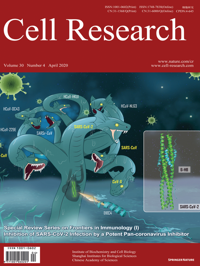
Advanced Search
Submit Manuscript
Advanced Search
Submit Manuscript
Volume 30, No 4, Apr 2020
ISSN: 1001-0602
EISSN: 1748-7838 2018
impact factor 17.848*
(Clarivate Analytics, 2019)
Volume 30 Issue 4, April 2020: 363-365
Hypercholesterolemia risk-associated GPR146 is an orphan G-protein coupled receptor that regulates blood cholesterol levels in humans and mice
Fangfang Han1 , Xiao Liu1 , Chuanfang Chen1 , Yinan Liu1 , Mingkun Du1 , Yu Zhou1 , Yong Liu1 , Bao-Liang Song1 , Housheng Hansen He2,3 , Yan Wang1,*
1Hubei Key Laboratory of Cell Homeostasis, College of Life Sciences, Wuhan University, 430072 Wuhan, Hubei, ChinaDear Editor,
Hypercholesterolemia is the leading risk factor for cardiovascular diseases. Current evidence suggests that the heritability for blood cholesterol levels is high, with 40%–60% in different cohorts.1,2 Genome-wide association study (GWAS) is a powerful tool to ascertain the contribution of common genetic variants in population-wide disease variability. It has been performed extensively on blood lipids traits and hundreds of genome variants are associated with dyslipidemia. However, approximately 95% of these variants are located in genome noncoding regions and cluster in more than 300 loci in different populations.3 We find that approximately 2/3 of these loci are located in noncoding regions and are not close to any gene that known plays a role in lipid metabolism. The disease-causing variants in these loci and the molecular mechanisms remain largely unknown, which prevents the interpretation of the GWAS results and their application in precision medicine. On the other hand, these noncoding regions may harbor novel genes or signaling pathways involved in lipid metabolism and be a valuable resource for further mechanistic studies.
https://doi.org/10.1038/s41422-020-0303-z